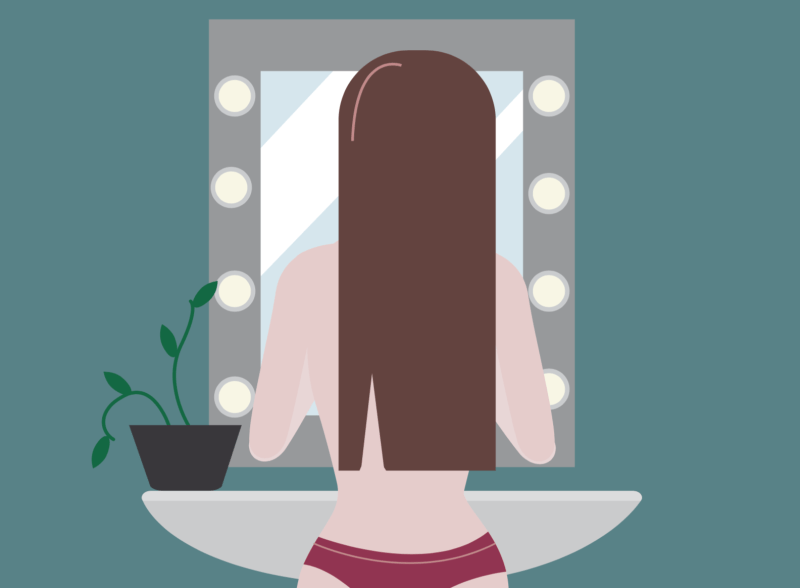People like essential workers who have to wear masks for prolonged periods of time may be experiencing undesirable skin side-effects, including acne breakouts, excessive dryness, and irritated skin. “Maskne,” a portmanteau of mask + acne, has now been added to our pandemic-related lexicon. Find out what maskne is, why you’re breaking out so much right now, and how to prevent maskne below.
Maskne Definition

Friction or pressure on your skin from the prolonged wear of facial personal protective equipment is a risk factor for acne. According to the American Academy of Dermatology Association (AAD), “Oils on your skin and particles that you breathe out collect on the mask. As these build up, they can irritate the skin covered by your mask.” Johns Hopkins points out that the places covered by a face mask—the skin around the nose, mouth, and chin—are already quite delicate.
The medical term for maskne is acne mechanica, which is basically acne that is exacerbated by rubbing or friction, as in with mask wear. Many industries require people to wear respiratory protective devices to reduce exposure to airborne contaminants, so maskne is nothing new. However, now that a plethora of people have to wear masks to prevent the spread of COVID-19, it is becoming a more common phenomenon.
Why You’re Breaking Out So Much RN

In addition to the irritation from your mask, a humid environment and pandemic-induced stress also promote acne. Breathing, talking, laughing, etc,. while masked creates a warm, moist environment, which according to Cleveland Clinic is “an ideal setting for yeast, bacteria, and other flora, such as Demodex (types of skin mites that naturally live on our skin), to grow.”
Dermatologist Dr. Amy Kassouf says that this bacterial imbalance combined with friction from your mask can promote acne and rosacea flare-ups as well as something called perioral dermatitis, a rash that develops around the mouth and nose that resembles acne. If your small bumps are dry, scaly, itchy, or feel like they’re burning, you likely have a facial rash instead of zits.
How to Avoid Maskne

Girl, Wash Yo Face
Contrary to popular belief, acne isn’t caused by dirty skin. According to the Mayo Clinic, “Acne develops when sebum (an oily substance that lubricates your hair and skin) and dead skin cells plug hair follicles. Bacteria can trigger inflammation and infection resulting in more severe acne.”
To prevent clogged follicles, cleanse your face after wearing a mask. The AAD recommends using a gentle, alcohol-free cleanser that is not abrasive. “Scrubbing the skin too hard or cleansing with harsh soaps or chemicals irritates the skin and can make acne worse,” according to the Mayo Clinic.
Moisturize, Moisturize, Moisturize
It may seem counterintuitive to slap moisturizer on an already oily or greasy mug, but the AAD says to “use a non-comedogenic moisturizer after washing.” They recommend a gel moisturizer for those who are prone to breakouts. The BBC adds that “a lightweight moisturizer can also act as an additional protective barrier and prevent chafing” and recommends opting for a “more lightweight water-based products underneath the mask.”
Cloth Masks Are Best
Synthetic fabrics, such as nylon, polyester, and rayon are more likely to irritate your skin and cause breakouts, according to the AAD. If possible, wear masks that are made with tightly woven, soft cotton fabric.
Girl, Wash Yo Mask
Who hasn’t popped on their mask for a quick errand and then stuck it back in their bag instead of the dirty clothes? Both the CDC and the AAD recommend washing your mask regularly. Germs can be transferred to your mask or your face when you touch your mask, which could lead to a skin problem.
Get rid of the germs, oils, skin cells, and particles that have accumulated inside the mask by following the washing instructions included with the mask. When in doubt, wash in hot water using a fragrance-free, hypoallergenic laundry detergent.
Break Up With Makeup
One good thing that has come out of this chaos is that cosmetics have been canceled. While non-comedogenic (formulated not to clog pores) and oil-free makeup doesn’t necessarily worsen acne, it can worsen mask-induced skin problems. In addition, cosmetics are more likely to clog pores and lead to breakouts when worn beneath a mask. Luckily, your mask conveniently covers up whatever skin woes it has inadvertently worsened. If you can’t resist a little war paint, use an oil-free product, like mineral-based makeup.
Skincare Products to Help Prevent Maskne

When maskne attacks, more products may seem like the answer, but introducing new skincare products can actually irritate your skin. Board-certified dermatologist Dr. Daniela Kroshinsky states, “Wearing a mask for even a short time can make your skin more sensitive. To reduce skin problems, avoid trying harsh products, such as a chemical peel, exfoliant, or retinoid, for the first time.”
Since irritation delays healing, the AAD echos the sentiment that less of certain skincare products is more when it comes to an irritated visage. Until your skin heals, dermatologists recommend that you “stop applying skincare products and medications that can irritate your skin.”
Discontinue use of:
- Acne treatments that contain salicylic acid
- Anti-aging products
- At-home light devices
- Peels or scrubs
Even products that you usually use, such as retinoids can irritate your skin when you cover your face with a mask. “If you’ve been using a retinoid (or retinol), apply it at bedtime and don’t increase the amount that you apply” Dr. Kronshinsky advises.
When to Call the Derm

If your acne seems to be not just in the mask zone, you may want to switch up your diet. Milk and fatty and sugary products have now been associated with acne. If your skin isn’t clearing up after a few days, it’s time to consult a board-certified dermatologist who can determine the best treatment for your skin type. Right now, some derms are even taking patients through a teleportal.
